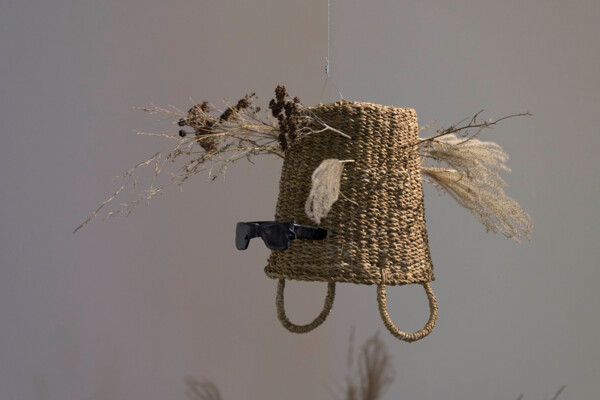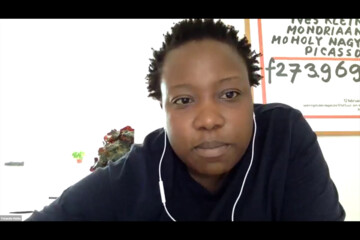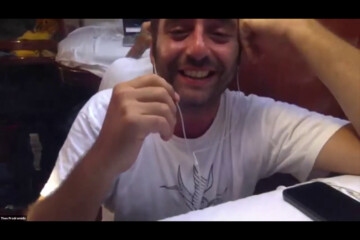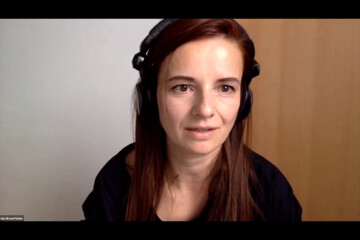Embracing a New Grammar: A Script for re-dit-en-un-in-(a)-learning
In recent conversations with artist Laure Prouvost, I have come to an expanded notion of the practice of unlearning – a term that for her requires going back in time to get closer to a first discovery of a thing, as a child might experience it, relying on instinct (smell, taste).[1] Prouvost works from a place of abundance as far as language is concerned and yields to no limitation. In this spirit, unlearning can be practised in various ways when envisioned as re-dit-en-un-in-learning.
re-dit-en-un-in-(a)-learning
“Re-learning” suggests a return to something once forgotten, and, according to a common dictionary definition, is “a method of measuring the retention of learned material by measuring how much faster a person can relearn material that had been previously learned and then forgotten”.
re-dit-en-un-in-(a)-learning
“Dit” is the past participle of the French verb “dire”, which means “to speak”, and is → translated loosely as “that is to say” or “called”. So, “so-called learning”? In Dutch, the context that I am writing this from, “dit” means “this” – translating to “this learning”. Developed for the Walker Art Center, Minneapolis, and later purchased by the Van Abbemuseum, Eindhoven, DIT LEARN is the title of the artist’s 2017 video with a lexicon at its centre consisting of terms stitched together in rapid succession and matched with images to break apart old meanings and create new ones. “Dit-learning”, perhaps synonymous with, concerns itself with liberation from oppressive systems once we’ve identified them.
re-dit-en-un-in-(a)-learning
I had to look up “en” in French, where it is used to replace a noun. What then of this in relation to the verbs “unlearning” and “inlearning”? This is an incomplete thought.
re-dit-en-un-in-learning
“Unlearning”, to my understanding, takes its cue from Gayatri Chakravorty Spivak’s concept of “unlearning one’s privilege”. It denotes an active critical investigation of normative structures and practices so that one might become aware and get rid of taken-for-granted theoretical and practical “truths” in order to tackle inequalities in everyday life. So, unlearning is not so much the divestment of specific skills, but of a habitus. And when applied to institutions, unlearning can entail a → process of de-instituting directed towards embodied forms of knowledge and the (un)conscious operation of ways of thinking and doing.
re-dit-en-un-in-(a)-learning
“In-learning” is fairly self-explanatory, but “a-learning” is another take on learning that perplexes me due to its French origins: “a” (no accent) is a conjugated form of the verb “avoir”, e.g., elle a un bateau (she has a boat). “À” (with accent grave! I gleefully recall the French I learned as a child) is commonly used as a preposition. Its meaning varies depending on the sentence (at, in, or to) – Prouvost uses all of them here: to be at learning, in learning, or to learn.
Re-dit-en-un-in-learning as commoning practice
Prouvost’s approach to taxonomy – her seemingly endless rubrics and matrixes for language – opens us up to the variety in understanding, and to a multiplicitous nature of being.[2] This is useful in its evocation of the practice of commoning (as a verb), in that language itself is reclaimed from its enclosures. Prouvost migrates across French, English, and at times other languages, to muddle syntax; she disassociates and reassociates; she suggests a new condition in which misunderstanding –experienced even in groups with sharing practices who are → invested in new and just ways of being, living, or working together – reveals a limitation in communication as well as possibilities for reconciliation and affective resources with new vocabularies, syntax, and narratives. These resources can break tensions around ideas to make way for knowing and meaning-making, revealing what can be learned on the verge of failed communication. At their best, Prouvost’s taxonomies also speak to how the commons are resources for uptake and practice by a community that is dedicated to difference.[3]
The Re-dit-en-un-in-learning CENTER is the name of the artist’s latest pedagogical project, which follows some of the logic and notions introduced in DIT LEARN. At its centre is a video called Re-dit-en-un-in-a-learning (2020), which is co-produced by Lisson Gallery and the Van Abbemuseum, Eindhoven, and the presentations of the work in the institutions echo one another. At the Van Abbemuseum, Prouvost’s video installation is presented in the context of the group exhibition Bodywork, (Figure) which addresses the different ways in which our bodies are used for and by contemporary society, as informed by, for example, technology – the correspondence between humanity’s engagement with the → earth and the future of our existence in technological society.[4] Ivan Illich’s prophetic 1983 essay, “→ Silence Is a Commons: Computers are doing to communication what fences did to pastures and cars did to streets”, captures the fraught relationship between people and their machines. He gives a history of how pastures and roads have been converted from commons-owned and used to being controlled by a few as a result of electronic devices. He relays this lesson through a story about the first loudspeaker arriving on the Island of Brač, off the coast of Croatia, in 1926, thereby disrupting the democracy of communication on the island.[5] While Illich could not have foreseen how the internet would evolve, his critique of “computer-managed society” falls short of envisioning the internet as both a commons and a resource, exemplified by the newly widespread online conference during the COVID-19 pandemic, bringing people from different localities together over time and space. In this light Prouvost’s practice seems to address both Illich’s concerns and the positive possibilities of technology. For her, language-making is a technology mechanised through play, the body, and the re-dit-en-un-in-learning installation environment that she creates to introduce fundamental new options in human communication. The viewer is invited to engage in language recipes that are experienced through the body and in the → imagination.
 Laure Prouvost, Positions #6 Bodywork, installation view, 2020–2021. Courtesy of Van Abbemuseum, Eindhoven. Photo: Peter Cox.
Laure Prouvost, Positions #6 Bodywork, installation view, 2020–2021. Courtesy of Van Abbemuseum, Eindhoven. Photo: Peter Cox.
Teaching to unlearn: re-dit-en-un-in-learning codex
The video Re-dit-en-un-in-a-learning is conceived as a playful didactic environment with video, audio, and text elements that encourage corporeal and tactile engagement. The installation evokes a kind of mock school, befitting of the speculative word games outlined above. Visitors are invited to undergo a process of de-learning or unlearning that which they have forgotten they already know, to re-learn a language or legsicon devised by the artist and fostered by the institutional setting in which this learning happens through the senses: a play on “lexicon”, the “legs” refer to the many legs of the octopus, a recurrence in Prouvost’s practice that refers to multitude and meaning. “An octopus has its brain in its tentacles,” Prouvost once professed in conversation. “Clap your hands together! Can we think and feel as quickly as we touch?” Just as she encourages beings to think at the speed at which they experience touch, at times in the video, the camera lens follows the purview of a goat – which you learn is a representation of you in the codex – meandering in a city, animal driven dérive, with bodies closer to the sidewalk. What types of learning happen closer to the level of the ground as opposed to a bird’s-eye view? Such is the imagination afforded by corporeal learning, one’s memory of the lessons of the codex is put to the test by the video.
In Re-dit-en-un-in-learning CENTER, Prouvost furthers exploration into the nature of how systems are constructed and meaning is made. Suddenly, imaging alternative ways of knowing is less of a daunting task associated with knowledge production, instead joy and play may be foregrounded as tools and not indulgences. Here meaning-making relies equally on sensorial experiences as it does cognition through the brain. When cheese was brought to South Africa, it was called isonka se mazi (water like bread) in isiXhosa, we learn from artist and legsicon proficient Simnikiwe Buhlungu. The naming was based on its smell, taste, and feel. When Prouvost speaks both in person and in her video scripts, her language is also rich in adjectives and onomatopoeia, drawing listeners and readers in, making them complicit in the work unfolding before them as they lean into her grammar and corporeal ways of understanding. This logic extends to the contributors to this publication, whose texts are determined by the artist’s codex.
A new grammar learned, now what?
Naturally, such linguistic frameworks are prone to misuse and bastardisation; the strength and limitation of Prouvost’s work lies in its emphasis on the beholder as translator or interpreter. As we enter the reality of the second or third wave of the COVID-19 global pandemic, haunting questions come to the surface around which lessons we want to maintain in order not to return, full circle, to the “business as usual” rhetoric about sustained practice towards systemic change.
True to the artist’s form, Re-dit-en-un-in-learning CENTER’s legsicon is informed by conversations around the artist at the time of the pandemic. She has captured a range of expressions, from repetitive movements and slowness to eating for a healthy immune system (probiotic-rich foods and vitamin concoctions) and institutional care practices. The mock education centre then is a distillation and registration of terms that have found a new dominance in the artist’s pandemic reality. The collection operates as a guide to best practices to carry forward. As the communication team at Lisson Gallery has pointed out, when visitors leave the installation, “induction is over and the real-world examination begins”. Language systems are idiosyncratic and neither universal nor objective: application of this lesson is a tool for conjuring that which we do not yet imagine. This has been further developed by the contributors to this publication – fellow users or companions of the re-dit-en-un-in-learning codex. Following the saying that history doesn’t repeat itself, but it often rhymes, this pandemic period can be described in terms of a stutter: What lessons might we draw from those who have lived through and survived catastrophes to make new realities?





